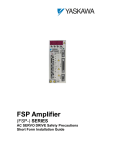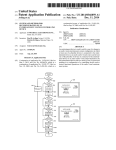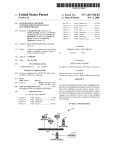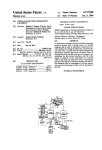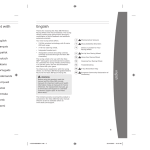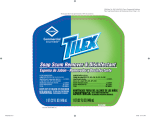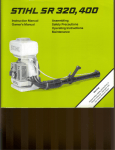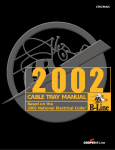Download za?trronsducerH sumniofor I:
Transcript
Aug. 22, 1961 T. R. SCHUERGER ET AL Filed June 4, 1958 2,997,205 METHOD AND APPARATUS FOR CONTROLLING DISCHARGE OF MATERIALS 2 Sheets-Sheet l ! 20 23\ speed 22 A 3” ——compuling 2/ circa/‘l ' 3" 1 1 memory device ‘ - 1 motor control za?trronsducerH sumniofor I: + I / 55 ’ amp. 27 By Aug. 22, 1961 T. R. SCHUERGER ETAL 2,997,205 METHOD AND APPARATUS FOR CONTROLLING DISCHARGE OF MATERIALS Filed June 4, 1958 - dc. 2 Shee‘ts-Sheet 2 TE: 3 E 30 56 l0 m0/0r32 D, 0 FIG? 4 - 75 " TIMER 70 " ?' ' "01v TIME" A ‘ "0FF TIME” "01v TIME " TIME‘? 7/ __[ ——-—--s TIME/i’ 72 A-——---——--— ----- 'oFF r/MF" —_¢ —- "01v TIME" I —— _- -N TIMER 73 "oFF T/MF” "am TIME” "OFF TIME ” IN VE/V TOPS THOMAS H. SCHUERG‘ER and FRANK SLAM/U? 5! Altar/1 ey ,. United grates Patent 0 ” 1C@ 1 2,997,205 Patented Aug. 22, 1961 2 a portion of a sinter feed compounding apparatus equipped 2,997,205 METHOD AND APPARATUS FOR ‘CONTROLLING DISCHARGE 0F MATEREALS Thomas R. Schuerger and Frank ‘Slamar, Monroeville, Pa., assignors to United States Steel ‘Corporation, a corporation of New Jersey Filed June 4, 1958, Ser. No. 739,870 '18 ‘Claims. (Cl.222--1) with a control mechanism in accordance with our inven tion; FIGURE 2 is a schematic wiring diagram of a speed computing circuit, calibration device, memory device and motor control embodied in our control mechanism; FIGURE 3 is a schematic wiring diagram of a timer circuit embodied in our mechanism; and FIGURE 4 is a graph showing the operating sequence. This invention relates to an improved mechanism and 10 FIGURE 1 shows a portion of a sinter feed compound method for controlling discharge of material from a bin ing apparatus similar to that of the aforesaid earlier ap or the like. plication. The portion shown includes the discharge end An earlier application of the present co-inventor of a main conveyor belt 10 carrying a bed of material M, Schuerger Serial No. 579,326, ?led April 19, 1956, now a bin 12 supported above the belt and containing hot abandoned, discloses an apparatus and method for auto matic proportioning of ingredients of a sinter feed ap 15 recycle R, a table feeder 13 at the bin discharge, and a vibratory conveyor 14 carrying hot recycle from the plicable especially to iron ore. (A continuation-in-part of table feeder to the ‘belt. A variable speed D.-C. motor the earlier application issued as Patent No. 2,980,291, 15 drives the table feeder, and the quantity of hot recycle April 18, 1961). The apparatus includes a main con discharged from the bin is a function of the speed of veyor belt, a series of bins located above the belt and 20 this motor. The material M consists of ore (for ex containing the individual ingredients, and table feeders for feeding these ingredients in controlled quantities to the belt. Several bins nearest the feed end of the belt contain ore ?nes and equivalents. The next bins con ample iron ore) and additives previously fed to the belt, and protects the belt from direct contact with hot re cycle, which commonly is at a temperature su?icient to burn the belt. The belt runs over a ?rst belt scale 16 tain additives, such as coke and anthracite ?nes, ?ue dust 25 immediately before hot recycle feeds thereto and a second and sized returns. The bin nearest the discharge end of belt scale 17 immediately after. The difference in weight the belt contains hot ?nes returned from the sintering ma registered by these scales represents the actual weight of chine for recycling. These ?nes, known as “hot recycle,” 'hot recycle reaching the ‘belt. The scales transmit signals ‘ are another equivalent of ore and must be used approxi to a summator 18, which continuously computes this dif rnately as received, except that the bin allows sui?cient 30 ference. The scales and summator can be similar to cor surge capacity to permit their feeding to the belt at uni responding parts in the earlier application; hence they form rates for reasonable periods. The invention claimed are shown only in block diagram in the present applica in the earlier application concerns a control for auto tion. Material discharging from the belt is moistened, matically proportioning additives in accordance with com mixed in a pug mill, and sintered as in the earlier ap bined weight of ore and hot recycle, even though hot 35 plication. recycle reaches the ‘belt after the additives. The mech Bin 12 is equipped with a device for sensing the level of anism and method of the present invention are particu hot recycle therein. The preferred sensing device in larly suited for controlling the discharge of hot recycle cludes lower and upper radiation-sensitive “Ohmart” cells from its bin to the main conveyor in a system like that shown in the earlier application. Nevertheless the in 19 and 20 mounted on an outside wall of the bin and cor responding radiation sources- 21 and 22 mounted on the vention is not thus limited, but may be applied else where to overcome analogous problems. An object of the present invention is to provide an improved mechanism and method for controlling dis opposite outside wall. The lower cell 19 ‘and radiation source 21 de?ne the lower limit of the predetermined range within which the hot recycle level is maintained, and the upper cell 2t) and radiation source 22 the upper charge of material ‘from a bin or the like to hold the 45 limit. When radiation from either radiation source passes level of material in the bin within a predetermined range. through material in the bin' before reaching the corre A further object is to provide an improved mecha nism and method for controlling discharge of material from a bin by sensing whether the level of material in the bin is within a predetermined range and, if out of sponding cell, the quantity of radiation reaching the cell is at a minimum. As known in the art, each cell may be compensated by a second cell connected in opposition (not shown) so that the cell transmits no signal when this range, periodically changing the discharge rate by receiving minimum radiation. This device has the ad increments ?rst to return the level to the range and thereafter to hold it within the range. A more speci?c object is to provide an improved mech vantage that it eliminates any need for mechanical con tacts or probes within the bin where they are easily damaged; otherwise a mechanical device would be large control by changing the discharge rate by both a tem porary increment to return the level to the predetermined range and a permanent increment to hold it in this range. predetermined range, only cell 20 transmits va signal. When the level is too low, both cells transmit signals; when too high, neither transmits a signal. The cells anism and method which afford the foregoing type of 55 ly equivalent. When the hot recycle level is within the A further object is to provide the foregoing type of and radiation sources are not shown in detail, since suit control, but to delay changes until compensating changes 60 able devices are known and available commercially. are made elsewhere, for example in an apparatus for compounding sinter feed, to delay changes in hot recycle Nevertheless reference may be made to Ohmart Patent No. 2,763,790 for a detailed showing of one such ar rangement. The cells 19 and 20‘ of the sensing device transmit sig A further object is to provide the foregoing type of 65 nals to a periodically acting speed computing circuit 23. discharge rate until the ore feed rate has been changed inversely. control, and to include means for periodically and auto matically calibrating the mechanism. In accomplishing these and other objects of the inven tion, we have provided improved details of structure, a preferred form of which is shown in the accompanying drawings, in which: FIGURE 1 is a diagrammatic side elevational view of If the level is outside the predetermined range when the circuit acts, the discharge rate from the bin should be changed, and circuit 23 computes a new speed for motor 15 to effect such change. This new speed equals the alge braic sum of the instant speed, a temporary increment to bring the level back to the predetermined range, and a permanent increment to hold it in this range. Both 2,997,205 . ~ , a 3 4 increments are‘ of course negative when the level is too low and positive when too high; If the level'returns is too low, both contacts 19a and 20a open and both relays A and B ‘are deenergized. When the level is within the predetermined range, contacts 19a close and relay A picks up. When the level is too high, both contacts 19a and 20a close and both relays pick up. Relays A and B control a pair of relays C and D, which in turn control the application of negative and positive from outside the range to within the range, when the cir cuit again acts, it computes another new speed which equals the instant speed with the temporary increment discontinued. Circuit 23 transmits a signal representative of the most recently computed speed for motor 15 to a calibration device 24 and to a memory device '25. If the speed computed for the next period is the same as for the temporary speed change increments respectively. The coil of relay C is connected across lines 30 and 31 in present speed, this’ signal merely remains constant. The 10 series with back contacts A1 of relay A and front contacts circuit 23, calibration device 24 and memory device 25 are shown only in block diagram in FIGURE 1, but are shown more completely in FIGURE 2 and described in E1 of a relay E of the timer circuit. Similarly the coil of relay D is connected across these lines in series with front contacts B1 of relay B and front contacts E2 of relay B. As hereinafter explained, relay E automatically The calibration device 24 also receives a signal from 15 and periodically picks up for brief intervals. If the level more detail hereinafter. the summator 18 representative of the actual weight of hot recycle feeding to belt 10. Even though the motor speed may remain constant, the weight may vary slightly due to such factors as changes in characteristics of the hot recycle or wear of the parts. Since the summator commonly is a pneumatic pressure device and the cali bration device is electric, a transducer 26 can be inter posed between the two to convert the pressure signal to in the bin is within the predetermined range when relay E picks up, neither relay C nor D picks up, since both con tacts A1 and B1 remain open. If the level is too low, relay C picks up with relay E, since relay A is deener gized and its contacts A1 closed. Similarly if the level is too high, relay D picks up with relay E since relay B is energized and its contacts B1 closed. Whenever either relay C or D picks up, it seals in via back contacts E3 or E4 of relay E and its own front contacts C1 or D1. Relays a proportionate electric signal. The calibration device transmits a signal representative of the weight of hot re 25 C and D are relatively slow-acting to enable them to re main energized during the interval contacts E1 and E2 are cycle to be fed at the most recently computed motor speed opening and contacts E3 and E4 closing. After a tem— through a line 27 to a suitable device, not shown, for porary increment in the discharge rate returns the level computing the combined weights of ore and hot recycle feeding to the belt. Consequently a compensating change to the predetermined range, contacts A1 or B1 immediately open. The next time relay E picks ‘up and opens its con can be made in the ore feed rate either if a change in tacts E3 or E4, relay C or D drops out and the temporary the speed of motor 15 is to be made or if there is a change increment is discontinued. in the weight of hot recycle feeding at the present speed. Relays A and B also control a reversing motor 32 which i The transducer 26 is not shown in detail, since devicm in turn controls the application of permanent speed suitable for this purpose are known and available com mercially. Nevertheless reference can be made to Carl 35 change increments. This motor is connected across lines 30 and 31 in series with back contacts A2 and A3 of relay son Patent No. 2,059,549 for a detailed showing of one such device. The device which receives the signal from A and front contacts E5 and E6 of relay E ‘for energizing it in one direction, and in series with front contacts B2 to corresponding parts shown in the earlier application; and B3 of relay B and the same contacts E5 and E6 for hence their showing is not repeated. If needed, an elec 4:0 energizing it in the opposite direction. If the level is within the predetermined range when relay E picks up, tric-to-pneumatic transducer can be used to convert the the motor does not operate, since contacts A2, A3, B2 and electric signal from the calibration device to a pressure line 27 and the parts associated therewith can be similar signal for use in these parts. For a showing of a device suitable for this last purpose reference can be made to a B3 are all open. If the level is too low, the motor runs in a direction to apply a negative increment, since relay A is deenergized and contacts A2 and A3 are closed. publication by the Foxboro Company, Foxboro, Massa Similarly if the level is too high, the motor runs in the chusetts, Bulletin 20-16 entitled “EMF Pneumatic Trans opposite direction to apply a positive increment, since mitter.” relay B is energized and contacts B2 and B3 are closed. When circuit 23 computes a new speed for motor 15 In either event the motor stops when relay E drops out di?erent from the instant speed, the memory device 25 retains the instant speed until compensating changes are and opens its contacts E5 and E5, thus limiting the mag made in the ore feed rate and until belt lit travels a 50 nitude of the permanent increment. The circuit includes a potentiometer 33 whose slide sufficient distance that the altered portion of ‘bed M reaches wire is connected to a suitable D.-C. source for develop~ the discharge end of vibratory conveyor 14. At the proper ing a speed controlling voltage. The potentiometer has moment the signal from circuit 23 representative of the an arm 34 which is electrically connected to an output newly computed speed acts on the memory device. There~ upon the memory device transmits this signal to a motor terminal 35 via two variable resistances 36 and 37 in series, and is mechanically connected to motor 32. Back control 28, which changes the speed of motor 15 to the contacts C2 of relay C are connected in parallel with newly computed speed. This speed (including any tem a portion of resistance 36 and thus normally shunt out porary increments) is held until the cycle repeats. The this portion of the resistance. When relay C picks up motor control is shown only in block diagram in FIGURE 1, but is shown more completely in FIGURE 2 and de 60 as a result of a low level of material in the bin, contacts C2 open and place the entire resistance 36 in series with scribed in more detail hereinafter. arm 34 and terminal 35. Consequently the voltage Speed computing circuit transmitted to the terminal drops to effect a negative FIGURE 2 shows our speed computing circuit 23 more temporary speed increment. Front contacts D2 are con completely, but omits the applicable portion of the timer 65 nected in parallel with a portion of resistance 37. When circuit shown separately in FIGURE 3. Circuit 23 is relay D picks up as a result of a high level of material energized through lines 30 and 31 connected to a suitable in the bin, contacts D2 close and shunt out a portion of D.-C. source. Cell 19 or its mechanical equivalent con trols contacts 19a which are connected across these lines in series with the coil of a relay A. Cell 20‘ or its me chanical equivalent controls contacts 26a which are con nected across the lines in series with the coil of a relay B. In each instance the contacts open when the correspond ing cell transmits a signal, and close when material in bin 12 outs oif the signal. Thus when the level of material the resistance in series with arm 34 and terminal 35. Consequently the voltage transmitted to the terminal rises to e?ect a positive temporary speed increment. The magnitude of temporary increments can be adjusted by adjusting resistances 36 and 37. When motor 32 runs, it moves arm 34 along the slide wire in a direc tion to lower or raise the voltage transmitted to the terminal to e?ect a negative, or a positive permanent 2,997,205 speed increment. The magnitude of permanent incre 3 servomotor.‘ Periodically relay F picks up for a de?nite ments can be adjusted by adjusting the length of time interval and then drops out. The ampli?er 44 and servo the motor runs. The ultimate voltage on the output motor are energized for this interval and deenergized at terminal 35 is proportionate to the most recently com its conclusion. puted speed for motor 15 and is transmitted to both the The action of the integrator can be explained mathe calibration device 24 and memory device 25. This volt matically as follows: age remains constant from the moment it is set until the Let next time relay E picks up, and even then remains con e1 represent the input voltage to the ampli?er propor stant unless a speed change is needed. tionate to the weight of hot recycle; 10 Calibration device e2 represent the input voltage to the ampli?er derived from the tachometer-generator; FIGURE 2 also shows the calibration device 24 more completely, but again omits the applicable portion of t represent the time interval the servomotor runs for each calibration; the timer circuit shown separately in FIGURE 3. The calibration device includes a potentiometer 40 whose 15 x represent the number of revolutions of the tachometer generator during the time t. slide wire is electrically connected to terminal 35 of the speed computing~ circuit, whereby the voltage applied Then to the slide wire is proportionate to the most recently (92-61) is the effective voltage which tends to drive the computed speed of motor 15. The potentiometer has servomotor; and an arm 41, which is mechanically connected to a cali 20 brating servomotor 42 and electrically connected with gis the angular velocity of the tachometer-generator. line 27. As hereinafter explained, the servomotor sets the arm 41 in accordance with a proportionality factor representative of the Weight of hot recycle which has been feeding. When the voltage transmitted from the 25 output terminal 35 changes, line 27 immediately trans mits a voltage proportionate to the weight of hot recycle to be fed at the new motor speed, assuming any imme e2=K-% (e2— el) = 151%‘; diate change inthe rate of feeding is directly propor tional to the change in motor speed, that is, a constant 30 K?-— =Kliidig The calibration device includes an integrator 43, which computes an average rate of feeding for a portion of the period after the memory device 25 and motor con e1: (Ir-Keg proportionality factor. 1 trol 28 have operated but before the next operation 35 of the speed computing circuit 23, and thus eliminates any effect of minor ?uctuations in the rate of feeding at any given motor speed. The integrator comprises an Thus it is seen that x is a function of e1, and measure electronic conversion ampli?er 44, a servomotor 45, and a tachometer-generator 46. The ampli?er has the char 40 ment of x over a de?nite time interval can be used to obtain an average value of e1 or the average rate at acteristic that it energizes the servomotor in the appro which hot recycle feeds for the same interval. priate direction whenever its input terminals are at dif The tachometer-generator is mechanically connected ferent voltages, but stops the servomotor when they are at the same voltage. The ampli?er per se is a known device and hence has been shown only in block form, to the arm 49 of a potentiometer 50- through suitable reduction gearing. At the beginning of a calibration but reference can be made to Wills Patent No. 2,423,540 45 cycle the arm is at a zero or grounded position. The distance the arm travels from this position during time for a complete showing of a suitable ampli?er of this type. A suitable ampli?er is available commercially interval 1‘ furnishes a measure of the number of revolu from Minneapolis-Honeywell Regulator Company under tions x during this interval. The slide wire of poten tiometer 50 is electrically connected to a suitable D.-C. voltage source, whereby arm 49 transmits a voltage pro portionate to the average rate at which hot recycle has the trade name “Electronik,” No. 356,358 and is de scribed in a printed publication by the manufacturer entitled “Service Manual 15019M for Class 15 ‘Elec fed during the interval 2‘. ‘ tronik’ Instruments” issue 8 (1956). The servomotor After the computed rate has been utilized to set the is a two-phase A.-C. induction motor which has the potentiometer arm 41, as hereinafter explained, the characteristic that under transient conditions its speed varies with the voltage applied to its ?eld. We have not 55 potentiometer arm 49 is reset to its‘ zero position. For this purpose the connection between transducer 26 and described the motor in detail since it likewise is a known the ?rst input terminal of ampli?er 44 contains contacts device, but for a complete description reference can be G1, and the connection between the generator 46 and the made to Thaler and Brown “Servomechanisms Analysis,” other input terminal contains contacts G2, which contacts copyright 1953 by McGraw-Hill Book Company, Inc., 60 are in a relay G of the timer circuit and are closed while pages 63 and 391. the integrator is averaging the feed rate. Contacts G3 The ampli?er 44 and servomotor 45 are electrically of relay G ‘are adapted to connect the ?rst input terminal connected to a suitable A.-C. source 47 which contains to a ground 51. Contacts G; of relay G are adapted to front contacts F1 of a relay F of the timer circuit in connect the other input terminal to arm 49 of the potenti series with the servomotor. One input terminal of the ampli?er is electrically connected to the transducer 26, 65 ometer 50. Additional contacts G5 of relay G are adapted whereby the voltage applied to this terminal is propor tionate to the Weight of hot recycle feeding to belt 10, but subject to minor ?uctuations. The other input ter to connect servomotor 45 to the A.~C. source 47, bypass ing the contacts F1. Contacts G3, G4 and G5 are open While the integrator is averaging the feed rate. When the potentiometer arm is to be reset, relay G picks up, where minal of the ampli?er is electrically connected to one of the output terminals of the tachometer-generator 46, 70 upon contacts G1 and G2 open and contacts G3, G4 and whereby the voltage applied to the latter terminal is pro G5 close. The servomotor 45 runs rapidly in the reverse direction until the voltages applied to the two input ter portionate to the generator output. The voltages applied 'to the two input terminals are of like polarity, but the minals of the ampli?er 44 are equal. Since one terminal latter is smaller. The output terminals of the ampli?er is grounded at 51, these voltages become equal when the .are electrically connected to a ?eld winding 48 of the 75 other terminal is grounded, that is, when the potentiom~ 2,997,205 ‘eter arm :49 reaches its zero setting. The integrator in elfect becomes a null-seeking device while it is resetting generator 65 and a magnetic ampli?er 66 which has a ‘the arm. portion of the motor-generator vare connected to suitable A.-‘C. sources. Arm 63 of potentiometer 62 is electrical Another electronic conversion ampli?er 55 controls the servomotor 42 which periodically sets the potenti ometer arm 4-1 in accordance with the proportionality factor. This ampli?er can be of similar construction to control winding 67. The magnetic ‘ampli?er and motor ‘ly connected to the winding 67 and continuously transmits thereto a voltage proportionate to the most recently ap plied speed for motor 15. The magnetic ampli?er is ‘connected to a ?eld winding 68 of the D.-C. generator, that used in the integrator. One input terminal of whereby the voltage applied to the ?eld winding, and ampli?er 55 is electrically connected to the potentiom eter arm 49, whereby the voltage applied to this terminal 10 hence the voltage output of the generator, vary with the voltage applied to the control winding 67. The genera is proportionate to the average .rate of feeding just com tor is electrically connected to the D.-C. motor :15, whose puted by the integrator. The other input terminal is speed thus is governed by this same voltage. We have electrically connected to the slide wire 41. The output not described the magnetic ampli?er in detail since it is terminals of the ampli?er are connected to a ?eld vwinding 56 of servomotor 42. The ampli?er and servomotor are 15 a known device, but for a complete description reference can be made to Storm “Magnetic Ampli?ers,” copyright electrically connected to a suitable A.-C. source 57, 1955 by General Electric Company. An explanation of which contains front contacts H1 of a relay H of the timer circuit in series with the servomotor. After arm 49 has been set, relay H picks up and energizes the ampli the way a magnetic ampli?er can be used as a voltage regulator for a D.-C. generator appears on pages 418 and ?er and servomotor, which runs until arm 41 reaches a 20 419 of this publication. position along its slide wire such that the voltages ap plied to the two terminals of the ‘ampli?er become equal. Timer circuit The usual condition is that the servomotor moves arm FIGURE 3 is‘ a schematic wiring diagram of a preferred 41 only slightly if at all for each calibration. Any timer circuit. In addition to the relays C, D, E, F, G and voltage change on the slide wire of potentiometer 40 25 H already mentioned, this circuit includes another relay already has produced a change both in the speed of motor 1 and four interval timers 70, 7-1, 72, and 73. These 15 and in the rate at which hot recycle is feeding before timers are of a type which have an adjustable “off-time” the integrator performs its computation, as explained and an adjustable “on-time” that repeat as long as the hereinafter in the description of the timer circuit. Conse timer is running. Such timers per so are known and quently the distance which arm 49 travels along its slide 30 are available commercially; ‘hence no detailed descrip wire reflects this change in the feeding rate. A change in tion is deemed necessary. However reference can be the voltage applied to the second terminal of ampli?er made to a printed publication of General Electric Com 55 by reason of a change in voltage applied to potenti pany entitled “TSA-lS Industrial Interval Timer” for ometer 4i} is largely compensated by arm 49‘ having a complete showing and description. Relays C and D reached a different position on its slide wire and thus 35 are energized from D.-C. lines 30 and 31 already men applying a different voltage to the ?rst terminal. tioned. The other relays and the timers are energized from lines 74 and 75 connected to a suitable A.-C. Memory device FIGURE 2 also shows the memory device 25, again source. Timer 70' runs continuously and has contacts 70a and omitting the applicable portion of the timer circuit. The 40 70b which open during its “o?-time” and close during its memory device includes an electronic conversion ampli tier 6%, a servomotor '61, and a potentiometer 62. The ampli?er and servomotor are similar to corresponding “on-time.” The “on-time” de?nes the interval during which the speed computing circuit 23 computes a new speed if such is needed. The “off-time” de?nes the inter parts of the integrator. One input terminal of the ampli~ val between successive computations while the other ac ?er is electrically connected to the output terminal 35 45 tions take place. Contacts 70a and the coil of relay E of the speed computing circuit 23, whereby the voltage are connected in series across lines 74 and 75, and like applied to this terminal is proportionate to the most wise contacts 70b and the coil of relay J, whereby relays recently computed speed for motor 15. The other input terminal of the ampli?er is electrically connected E and J pickup during the “on-time” and drop out during the “off-time.” The way in which relay E controls relays The slide wire of 50 C and D and motor 32 already has been explained in to the arm 63 of potentiometer 62. this potentiometer ‘is connected to a suitable D‘.'C. source, whereby voltage applied to the terminal of the ampli?er the descriptionof the speed computing circuit 263. Relay I has three front contacts J1, J2 and I3 connected in series respectively with timers 71, 72 and 73 across lines 74 and wire. The ampli?er and servomotor are electrically con 75. These three timers do not run continuously like nected to a suitable A.-C. source 64, which-contains front 55 timer 70, but are set to operate through only a single contacts‘ Gs of relay G of the timer circuit in series with cycle‘of “off-time" and “on-time” whenever they are en the servomotor. As already mentioned, relay G also ergized. Otherwise any errors in timer synchronization controls resetting of the integrator 43 of the calibration would be cumulative and would soon upset the operating device 24. The servomotor 61 is mechanically connected sequence. When relay J picks up, timers 71, 72 and 73 is proportionate to the position of arm 63 along the slide to the potentiometer arm 63. As already explained, changes in the ‘hot recycle dis charge rate are delayed until compensating changes are made in the ore feed rate. After relay E drops out and 60 are energized and go into “off-time.” These timers have a second connection with line 75 via a conductor 76, whereby they continue to operate through the remainder of theircycles after relay I drops out. after an appropriate delay for this purpose, relay G After timer 70 shifts from “on-time” to “off-time,” picks up and energizes the ampli?er 6t] and s'ervomotor 65 there is a delay during which all the timers are in “off 61, as well as resetting the integrator. If the voltage time” to ‘allow any compensating changes in the ore feed transmitted from terminal 35 to the ampli?er has changed rate to be made and to allow conveyor 10 to travel a since the preceding operation, the servomotor runs and su?icient distance that 'such changes are re?ected in the adjusts the potentiometer arm 63 until the voltage trans bed of material M. Immediately following this delay, mitted from potentiometer ‘62 to the ampli?er again 70 the “on-time” of timer 71 commences. This timer has equals the ?rst voltage. Thereupon the servomotor stops contacts 71a which open when the timer is not running and relay G drops out until time for the next adjustment. and during its “oif-time” and close during its “on-time.” Contacts 71a are connected in series with the coil of re Motor control lay G across lines 74 and 75, whereby relay G picks up The motor control 28 illustrated includes a motor 375 during the “on-time” .of timer 71 but otherwise drops out. 2,997,205 10 The way in which relay G controls operation of the servomotor 6-1 to apply newly computed speeds to motor 15 already has been explained in the description of the taining the level of material in a bin within a predeter mined range. As applied to a compounding apparatus for sinter feed, the invention coordinates any changes in memory device. The way in which this relay controls re the discharge of hot recycle with compensating changes setting of the integrator 43 already has been explained in which must take place. The control also provides for its own automatic calibration. Most of the instruments used are of standard manufacture and readily available com the description of the calibration device. Timer 71 re mains in “on-time” long enought for these steps to be com pleted and then ceases to run for the remainder of the merically. cycle. While we have shown and described only a single em Next the “on-time” of timer 72 commences. This 10 bodiment of the invention, it is apparent that modi?ca timer has contacts 72a which open when the timer is not tions may arise. Therefore, we do not wish to be limited running and during its “off-time” and close during its to the disclosure set forth but only by the scope of the “on-time.” Contacts 72a are connected in series with the appended claims. coil of relay F across lines 74 and 75, whereby relay F 1. The combination, with a bin adapted to contain picks up during the “on-time” of timer 72 but otherwise 15 material to a level within a predetermined range, and a drops out. The way in which relay F controls the inte device for discharging material therefrom at a variable grating action of the integrator 43‘ already has been ex rate, of a control mechanism comprising means for sens plained in the description of the calibration device. The ing Whether the level of material in said bin is within or “on-time” of timer 72 de?nes the interval it mentioned in outside the range, and means operatively connected with this description. It should be pointed out that timer 72 20 said sensing means and said discharging device and oper allows the integrator to act during a period of the operat able when the level is outside the range for periodically ving cycle while no changes are taking place either in the changing the discharge rate both by a temporary incre ore feed rate or the hot recycle feed rate, and also that the integrator acts for most of the period between suc ment to return the level to the range and simultaneously by a permanent increment to hold the level in the range cessive operations of the speed computing circuit in order 25 after it has returned. to furnish a truly representative proportionality factor. 2. The combination, with a bin adapted to contain After integration is completed, timer 72 ceases to run. material to a level within a predetermined range, and a Next the “on-time” of timer 73 commences. This variable speed device for discharging material there timer has contacts 73a which open when the timer is not from, of a control mechanism comprising means for running and during its “off-time” and close during its 30 sensing whether the level is within or outside the range, “on-time.” Contacts 73a are connected in series with the and a speed computing circuit operatively connected with coil of relay H across lines 74 and 75, whereby relay H said sensing means and said discharging device and picks up during the “on»time” of timer 73, but otherwise operable when the level is outside the range to compute drops out. The way in which relay H controls the servo new speeds for the discharging device, the new speed motor 42 to set the calibration device 24 already has been including a temporary increment to return the level to the explained in the description of the calibration device. range and a permanent increment adapted to be applied simultaneously with the temporary increment to hold the level within the range after it has returned. 3. The combination, with a bin adapted to contain Timer 73 remains in “on-time” long enough for this step to be completed and then ceases to run for the remaining moments of the cycle. Shortly thereafter the “on-time” of timer 70 commences and the cycle repeats. material to a level within a predetermined range, and a Operating sequence variable speed device for discharging material there FIGURE 4 shows a typical sequence diagram for our mechanism when applied to a sinter feed compounding periodically ‘acting speed computing circuit operatively apparatus. Initially timer 70, which runs continuously, ‘is just going into “on-time,” and the other timers 71, 72 from, of a control mechanism comprising means for sensing whether the level is within or outside the range, a 45 connected with said sensing means and operable when the level is outside the range to compute a new speed for and 73 are starting to run and going into “oif-time.” Next said discharging device, the new speed equalling the timer 70 completes its “on-time” and goes into “off-time” algebraic sum of the instant speed, a temporary incre which continues for the remainder of the cycle. For the ment to return the level to the range and a permanent moment all four timers remain in “olf-time” to produce increment to hold the level within the range after it has the aforementioned delay. Next timer 71 goes into “on 50 returned, said circuit also being operable when the level time,” at the conclusion of which this timer ceases to returns from outside the range to within the range to run. Next, and for the greatest part of the cycle, timer compute another new speed for said discharging device 72 goes into “on-time,” at the conclusion of which this equalling the instant speed with the temporary incre— timer ceases to run. Finally timer 73 goes into “on-time,” ment discontinued, and means operatively connecting said 55 at the conclusion of which this timer ceases to run. circuit and said discharging device for applying newly computed speeds to said discharging device. Thereafter the cycle repeats with timer 70 going again into “on-time.” Typically a ‘full cycle requires about 30 minutes. material to a level within a predetermined range, a vari Timer 70 has about 5 to 10 seconds “on-time” at the able speed device for discharging material therefrom, and ' and about 5 to 10 seconds “on-time” and is idle for the said discharging device, the new speed equalling the 4. The ‘combination, with a bin adapted to contain beginning of the cycle and is in “off-time” for the rest 60 means for receiving material from said discharging de of the cycle. The “on-time” can be adjusted to adjust the vice, of a control mechanism comprising means for sens length of time motor 32 runs and hence the magnitude of ing whether the level is within or outside the range, a permanent speed increments. The ensuing delay at the periodically acting speed computing circuit operatively conclusion of the “on-time” of timer 70 lasts about 1 to 5 connected with said sensing means and operable when minutes. Timer 71 has about 1 to 5 minutes “off-time” 65 the level is outside the range to compute a new speed for rest of the cycle. Timer 72 has a few seconds longer “off-time” than timer 71 and about 20 to 25 minutes “on time.” Timer 73 has slightly less than 30 minutes “off time” and about 5 to 10 seconds “on-time.” However, these intervals are stated only to show a typical example, and may vary widely with different conditions. From the foregoing description it is seen that the pres ent invention affords a fully automatic control for main 75 algebraic sum of the instant speed, a temporary incre ment to return the level to the range and a permanent increment to hold the level within the range after it has returned, said circuit also being operable when the level returns from outside the range to within the range to compute another new speed for said discharging device equalling the instant speed with the temporary increment discontinued, and time delay means operatively connected with said circuit and said discharging device for applying 2,997,205 1.1 newly computed speeds to the latter after compensating , 12 range, a periodically acting speed computing circuit op eratively connected with said sensing means and operable changes are made with respect to said receiving means. 5. In an apparatus for compounding a mixture of in when the level is outside the range to compute new gredients, which apparatus includes a main conveyor speeds ‘for said discharging device to return the level to adapted to carry at least one ingredient, a bin adapted to 5 the range and hold it in the range after it has returned, contain another ingredient to a level within ‘a predeter a calibration device operatively connected to said Weigh mined range, ‘and a variable speed device for discharging ing means and said circuit for determining a propor said last named ingredient from said bin to saidconveyor, tionality factor dependent on the weight of said last named the combination therewith of a control mechanism com ingredient actually discharging at any speed of said dis prising means for sensing whether the level of the in 10 charging device and transmitting a signal representative gredient in said bin is within or outside the range, of the weight to be discharged at the most recently com periodically acting computing means operatively con puted speed, and time delay means operatively connected nected with said sensing means for computing new speeds with said circuit and said discharging device for applying for said discharging device to return the level to the range newly computed speeds to the latter after a delay to allow if sensed to be outside and to hold the level within the 15 compensating changes in the ingredients already on said range if sensed to be already within, and time delay means conveyor responsive to signals from said calibration de operatively connected with said computing means and vice. said discharging device for applying newly computed 9. In an apparatus for compounding a mixture of speeds to the latter after a delay to allow compensating ingredients, which apparatus includes a main conveyor changes in the ingredients already on said belt. 20 adapted to carry at least one ingredient, a .bin adapted 6. In an apparatus for compounding a mixture of in to contain another ingredient to a level within a pre gredients, which apparatus includes a main conveyor determined range, a variable speed device for discharging adapted to carry at least one ingredient, a bin adapted to said last named ingredient from said bin to said conveyor, contain another ingredient to a level within a predeter and weighing means for determining the actual weight of mined range, and a variable speed device for discharging 25 said last named ingredient received on said conveyor, the said last named ingredient from said bin to said conveyor, combination therewith of a control mechanism compris the combination therewith of a control mechanism com prising means for sensing whether the level of the in gredient in said bin in within or outside the range, a periodically acting speed computing circuit operatively connected with said sensing means and operable when the level is outside that range to compute a new speed for said discharging device, the new speed including a ing means‘ for sensing whether the level of the ingredient in said bin is within or outside the range, a periodically acting speed computing circuit operatively connected with said sensing means ‘and operable when the level is out side the range to compute a new speed for said discharging device, the new speed equalling the algebraic sum of the instant speed, a temporary increment to return the level temporary increment to return the level to the range ‘and a permanent increment to hold the level within the range 35 to the range and a permanent increment to 'hold the ‘level within the range after it has returned, said circuit also after it has returned, and time delay means operatively connected with said circuit and said discharging device for simultaneously applying both increments of newly being operable when the level returns from outside the range to within the range to compute another new speed computed speeds to the latter after a delay to allow com for said discharging device equalling the instant speed pensating changes in the ingredients already on said belt. with the temporary increment discontinued, a calibra tion device operatively connected to said weighing means and said circuit for determining a proportionality factor dependent on the (weight of said last named ingredient 7. In an apparatus for compounding a mixture of in gredients, which apparatus includes a main conveyor adapted to carry at least one ingredient, a bin adapted to contain another ingredient to a level within a prede termined range, and a variable speed device for discharg ing said last named ingredient from said bin to said con veyor, the combination therewith of a control mechanism comprising means for sensing whether the level of the ingredient in said bin is within or outside the range, a periodically acting speed computing circuit operatively connected with said sensing means and operable when the level is outside the range to compute a new speed for said discharging device, the new speed equalling the actually discharging at any speed of said discharging de vice and transmitting a signal representative of the weight to be discharged at the most recently computed speed, and time delay means operatively connected with said circuit and said discharging device for applying newly computed speeds to the latter after a delay to allow com pensating changes in the ingredients already on said con veyor in response to the signal from said calibration device. 10. In an apparatus for compounding sinter feed, which ment to return the level to the range and a permanent increment to hold the level within this range after it has apparatus includes a main conveyor adapted to carry a bed of ore ?nes and additives, the additives being pro portioned in accordance with the weight of ore ?nes and returned, said circuit also being operable when the level their equivalents, a bin adapted to contain hot recycle algebraic sum of the instant speed, a temporary incre returns from outside the range to within the range to to a level within a predetermined range, and a variable compute another new speed for said discharging device equalling the instant speed with the temporary increment discontinued, and time delay means operatively connected with said circuit and said discharging device for applying newly computed speeds to the latter after a delay to allow compensating changes in the ingredients already on the belt. speed device for discharging hot recycle ‘from said bin to said conveyor upon said bed, the combination therewith of a control mechanism comprising means for sensing whether the level of hot recycle is within or outside the range, periodically acting computing means operatively connected with said sensing means ‘for computing speeds for said discharging device to return the level to the 8. In an apparatus for compounding a mixture of in 65 range if sensed to be outside and to hold the level within the range if sensed to be already within, means for trans adapted to carry at least One ingredient, a bin adapted to mitting signals representative of the weight of hot re contain another ingredient to a level Within a predeter cycle to be discharged at the most recently computed mined range, a variable speed device for discharging speed to enable compensating changes to be made in said last named ingredient vfrom said bin to said con -70 the weights of ore and additives included in said ‘bed, gredients, which apparatus includes a main conveyor veyor, and weighing means for determining the actual weight of said last named ingredient received on said conveyor, the combination therewith of a control mech anism comprising means for sensing whether the level of the ingredient in said bin is within or outside the and time delay means operatively connected with said computing means and said discharging device for apply ing newly computed speeds to the latter after the com pensating changes have been re?ected in said bed. 2,997,205 13 14 11. In an apparatus for compounding sinter feed, which apparatus includes a main conveyor adapted to carry a 15. A method of maintaining the level of material in a bin within a predetermined range comprising discharg bed of ore ?nes and additives, the additives being propor tioned in accordance with the weight of ore ?nes and their equivalents, a bin adapted to contain hot recycle to a ing material from the bin at a substantially constant rate for a period, sensing Whether the level remains within or moves outside the range, periodically computing new level within a predetermined range, and a variable speed discharge rates when the level is outside the range, the device for discharging hot recycle from said bin to said newly computed rates equalling the algebraic sum of the conveyor upon said bed, the combination therewith of a control mechanism comprising means for sensing whether the level of hot recycle is within or outside the range, a instant rate, a temporary increment to return the level to the range and a permanent increment to hold it in the range after it has returned, and periodically changing the discharge rate to the newly computed rate. 16. A method of maintaining the level of material in a bin within a predetermined range comprising discharg periodically acting speed computing circuit operatively connected with said sensing means and operable when the level is outside the range to compute new speeds for said discharging device, the new speed including a ing material from the bin at a constant rate for a period, temporary increment to return the level to the range and 15 sensing whether the level remains within or moves out a permanent increment to hold the level within the range side the range, periodically computing new discharge rates after it has returned, means operatively connected with when the level moves outside the range, the new rates said computing circuit for transmitting signals repre equalling the algebraic sum of the instant rate, a tem sentative of the weight of hot recycle to be discharged at porary increment to return the level to the range and a the most recently computed speed to enable compensat~ permanent increment to hold it in the range after it has ing changes to be made in the weights of ore and addi tives included in said bed, and time delay means opera returned, periodically computing other new discharge rates when the level returns from outside the range to within the range, the last named new rates equalling the tively connected with said computing circuit and said discharging device for applying newly computed speeds instant rate with the temporary increment discontinued, to the latter after the compensating changes have been 25 and periodically changing the discharge rate to the newly re?ected in said bed. 12. In an apparatus for compounding sinter feed, which apparatus includes a main conveyor adapted to carry a bed of ore ?nes and additives, the additives being pro computed rate. 17. In compounding a sinter mix of individual ingre dients which include ore, additives and hot recycle, a method of controlling the addition of hot recycle com portioned in accordance with the weight of ore fines and 30 prising feeding hot recycle from a supply thereof at a their equivalents, a bin adapted to contain hot recycle to constant rate for a period, sensing whether the level of a level within a predetermined range, and a variable hot recycle in the supply remains within or moves out speed device for discharging hot recycle from ‘said bin side a predetermined range, periodically computing new to said conveyor upon said bed, the combination there rates for feeding hot recycle when the level moves out with of ‘a control mechanism comprising means for sens ing whether the level of hot recycle is or outside the range, a periodically acting speed computing circuit connected with said sensing means and operable when 35 side the range to return the level to the range and there after hold the level within the range, changing the other ingredients to compensate for changes in hot recycle at newly computed feed rates, and applying newly com the level is outside the range to compute a new speed puted feed rates to hot recycle after delays for com for said discharging device, the new speed equalling the 40 pensating changes to be re?ected in the mix. algebraic sum of the instant speed, a temporary incre 18. In compounding a sinter mix of individual ingre ment to return the level to the range and a permanent in crement to hold the level within the range after it has re dients which include ore, additives and hot recycle, a method of controlling the addition of hot recycle com turned, said circuit also being operable when the level prising feeding hot recycle from a supply thereof at a returns from outside the range to within the range to 45 constant rate for a period, sensing whether the level of compute another new speed :for said discharging device hot recycle in the supply remains within or moves out equalling the instant speed with the temporary increment side a predetermined range, periodically computing new discontinued, means operatively connected with said com rates for feeding hot recycle when the level moves out puting circuit for transmitting signals representative of side the range, the newly computed rates equalling the the weight of hot recycle to be discharged at the most 50 algebraic sum of the instant rate, a temporary increment recently computed speed to enable com-pensating changes to be made in the weights of ore and additives included to return the level to the range and a permanent incre ment to hold it in the range after it has returned, chang— in said bed, and time delay means operatively connected ing the other ingredients to compensate for changes in with computing circuit and said discharging device for ap hot recycle at newly computed feed rates, and applying plying newly computed speeds to the latter after the 55 newly computed feed rates to hot recycle after delays compensating changes have been re?ected in said bed. for compensating changes to be re?ected in the mix. 13. A combination as de?ned in claim 12 in which said apparatus also includes weighing means for deter References Cited in the ?le of this patent mining the actual Weight of hot recycle discharged to UNITED STATES PATENTS said conveyor and said means for transmitting signals 60 1,922,883 Crago ______________ _... Aug. 15, 51933 representative of the weight of hot recycle includes a 1,983,093 Montgomery __________ __ Dec. 4, 1934 calibration device operatively connected with said weigh ing :lieans for applying a proportionality factor to the 2,040,157 Story et a1. __________ __ May 12, 1936 sign 2,147,422 2,261,655 Bendz _______________ __ Feb. 14, Lowe ________________ __ Nov. 4, Lindholm ____________ __ Aug. 6, De Brabander ________ __ Nov. 18, Lowe _______________ __ Nov. 10, Hemmelheber ________ __ Mar. 13, Martin _______________ __ July 2, . 14. A method of maintaining the level of material in 65 a bin within a predetermined range, while continuously discharging material therefrom, comprising sensing wheth er the level is within or outside the range, periodically computing new discharge speeds when the level is sensed to be outside, which new speeds include a temporary 70 increment to return the level to the range and a perma nent increment to hold the level in the range after it has returned, and simultaneously applying both increments of newly computed speeds to the discharge. 2,381,505 2,618,395 2,658,644 2,737,997 2,797,702 1939 1941 1945 1952 l1953 1956 1957 FOREIGN PATENTS 729,633 Great Britain ________ __ May 11, 1955












